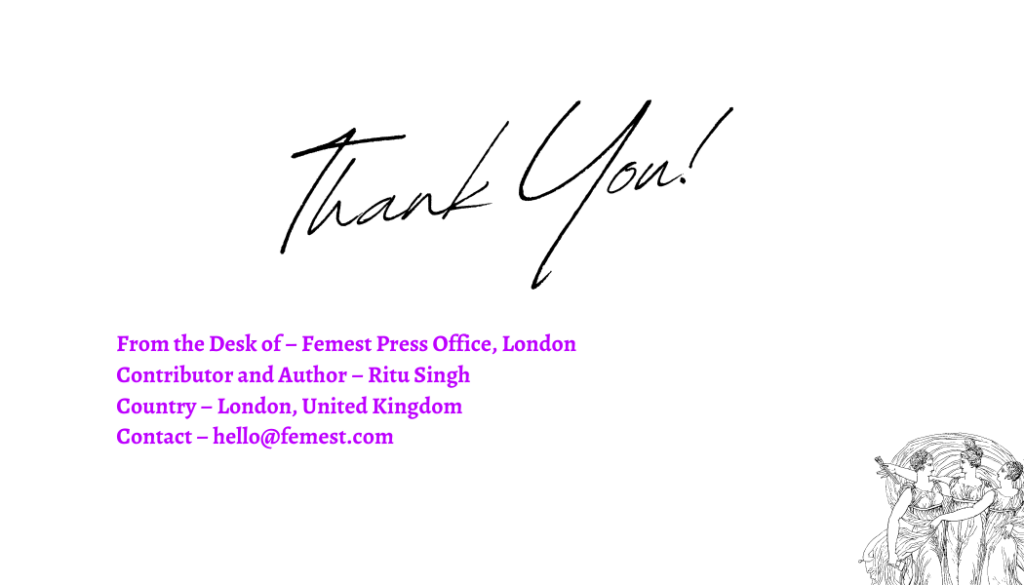A Journey of Resilience: Surviving and Thriving Beyond Bone Cancer.
A Saga of Survival: Exclusive Conversation with Sophie Loubet
Can you tell us about your journey and the challenges you faced during your 10-year battle with bone cancer, leading to the amputation of your right leg?
J’avais 23 ans lorsque des douleurs au niveau du genou sont apparues. Les médecins ne savaient pas ce que c’était jusqu’au jour où mon tibia s’est brisé, juste en marchant dans la rue. Diagnostic, ostéosarcome, cancer des os, qui m’avait mangé les ⅔ de mon tibia. J’ai été bien prise en charge en France, mais malheureusement, les médecins cherchent à sauver votre jambe coûte que coûte. Le cancer revenait à chaque fois, au bout d’un an, 2 ans voire même trois ans, et à chaque fois de manière plus agressive. La 4ème fois, les médecins m’ont parlé d’amputation. Je savais qu’il n’y avait pas d’autre choix. Mon seul regret est d’avoir accepté tous les traitements et chirurgies pendant 10 ans, car ça a été très dur, très douloureux et j’ai perdu 10 ans de ma vie.
I was 23 years old when I started having knee pain. Doctors didn’t know what it was until one day, I broke my tibia while walking down the street. The diagnosis was osteosarcoma, a bone cancer that had eaten away ⅔ of my tibia. I was well taken care of in France, but unfortunately, doctors are trying to save my leg at all costs. Each time, the cancer returned a year, two years or three years later, and each time more aggressively. For the fourth time, doctors talked to me about amputation. I knew there was no other option. The only regret I have is that I accepted all the treatments and surgeries for 10 years because it was tough and excruciating, and I lost 10 years of my life.
Q: How did you become associated with PROTEOR, the French orthopaedic leader? Could you share your experience of wearing the SYNSYS mechatronic prosthesis?
Au centre de rééducation, j’ai rencontré une très bonne orthoprothésiste de chez PROTEOR. Depuis le début, j’ai donc été appareillé par eux. Un jour, mon orthoprothésiste m’a demandé si j’étais d’accord pour essayer une prothèse de nouvelle génération. J’ai répondu que oui, mais je lui ai demandé : “Que faire si elle me plaît”?
En juillet 2020, un ingénieur de chez PROTEOR est venu pour me faire essayer cette prothèse, et on m’a demandé d’y apporter des chaussures à talons. Malheur ! Car j’avais jeté toutes mes chaussures car il était impossible avec les prothèses ordinaires de changer de chaussures. J’y suis allée avec les chaussures de mes copines et j’ai tout de suite très bien marcher avec cette prothèse, beaucoup mieux qu’avec ma prothèse de la sécurité sociale. Par chance, à ce moment-là PROTEOR cherchait des Égéries pour porter cette prothèse et les accompagner sur les événements promotionnels. J’ai donc tout fait pour la garder. On m’avait rendu ma jambe. Il était hors de question qu’ils la reprennent.
At the rehabilitation centre, I met a very good orthoprosthetist from PROTEOR. From the start, I was fitted by them. One day, my orthoprosthetist asked if I would try a new-generation prosthesis. I said yes, but I asked him: “What should I do if I like her”?
In July 2020, an engineer from PROTEOR came to have me try this prosthesis, and I was asked to bring heeled shoes. Misfortune! Because I had thrown away all my shoes because it was impossible with ordinary prosthetics to change shoes. I went there in my friends’ shoes, and I immediately walked very well with this prosthesis, much better than with my social security prosthesis. Luckily, PROTEOR sought muses to wear this prosthesis and accompany them to promotional events. So I did everything to keep her. They had given me my leg back. There was no way they were going to take it back.
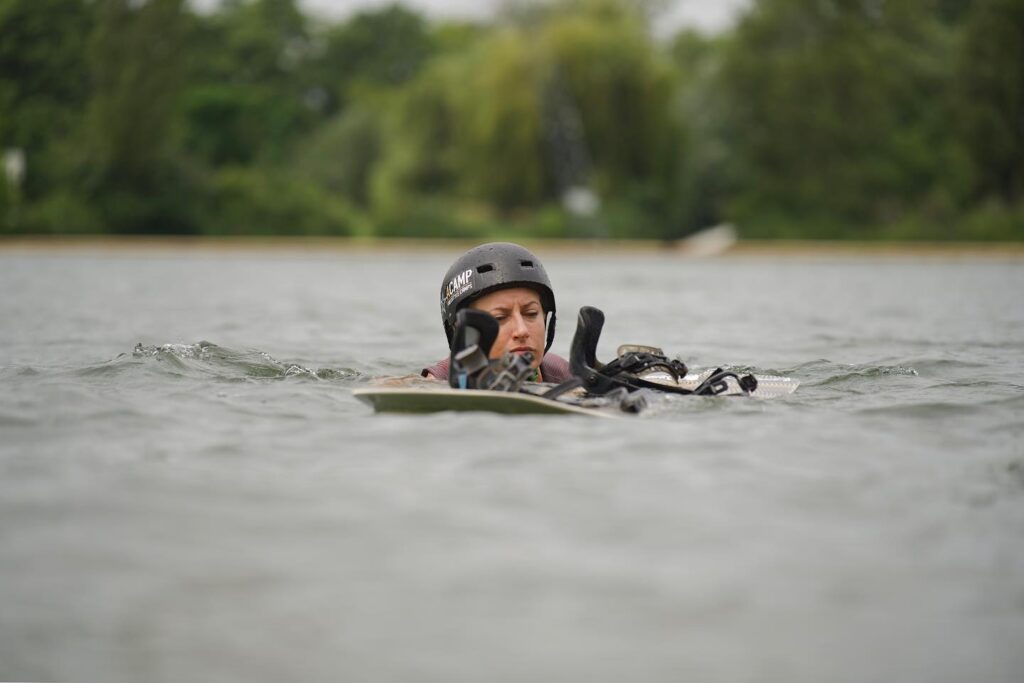
Q: As the patron of the “Génération Avant-Garde” association, could you explain the mission and goals of the association and why you are passionate about funding sports prostheses for amputees?
Lorsqu’on m’a amputé de la jambe, je suis devenue handicapée. Et là, toute ma vie s’est écroulée. En un clin d’œil, j’ai perdu mon travail, mon mari m’a demandé le divorce et j’ai dû partir de chez moi. A ce moment-là, j’avais deux choix, ou me laisser abattre, ou remonter la pente. Avant de tomber malade, je faisais beaucoup de sport, j’adorais ça. Je me suis donc rapprochée d’associations qui permettent d’essayer des prothèses de sport, et je suis partie faire du snowboard et du wakeboard avec des groupes. C’était tellement bien ! 10 ans que je n’avais rien fait ! Je me suis rendue compte que la vie méritait d’être vécue, même handicapée. Ça m’a permis de retrouver confiance en moi, de me trouver de nouvelles capacités et surtout de rencontrer plein de monde comme moi qui m’ont partagé leurs expériences et tout appris. Malheureusement, je n’avais pas de prothèse de sport. On m’en a prêté une pour faire du snowboard, et j’ai fait du wakeboard assise, en Sitwake, sans prothèse. Leur coût est élevé, beaucoup trop élevé pour n’importe qui. Heureusement, je faisais plein de choses pour Proteor, et ils m’ont prêté leur genou multisports avec lequel j’ai tout fait : du vélo, du kitesurf, du trampoline, du surf…etc. J’avais été detruite, et j’ai pu redevenir une femme forte. Grâce au sport, je me suis reconstruite. C’est pour toutes ces raisons que je suis devenue la Marraine de Génération Avant-Garde qui par le biais d’événements, de mécénat, et de dons, finance des prothèses de sports pour les personnes amputées. En 4 ans elle à pu offrir 9 prothèses qui ont coûté entre 10 et 20 000€ chacune.
When my leg was amputated, I became disabled. And then my whole life fell apart. In the blink of an eye, I lost my job, my husband filed for divorce, and I had to leave home. At that moment, I had two choices: let myself be defeated or get back on track. Before getting sick, I did a lot of sports; I loved it. So, I got in touch with associations that allow people to try out sports prostheses, and I went snowboarding and wakeboarding with groups. It was so good ! 10 years since I did anything! I realized that life was worth living, even when disabled. It allowed me to regain self-confidence, find new abilities and, above all, to meet lots of people like me who shared their experiences and taught me everything. Unfortunately, I didn’t have a sports prosthesis. I was lent one for snowboarding, and I did seated wakeboarding in a Sitwake without a prosthesis. Their cost is high, much too high for anyone. Fortunately, I was doing lots of things for Proteor, and they lent me their multi-sport knee with which I did everything: cycling, kitesurfing, trampolining, surfing…etc. I had been destroyed, and I was able to become a strong woman again. Thanks to sport, I rebuilt myself. It is for all these reasons that I became the Godmother of Génération Avant-Garde, which, through events, sponsorship, and donations, finances sports prostheses for amputees. In 4 years, she could offer 9 prostheses, which cost 10 and 20,000€ each.
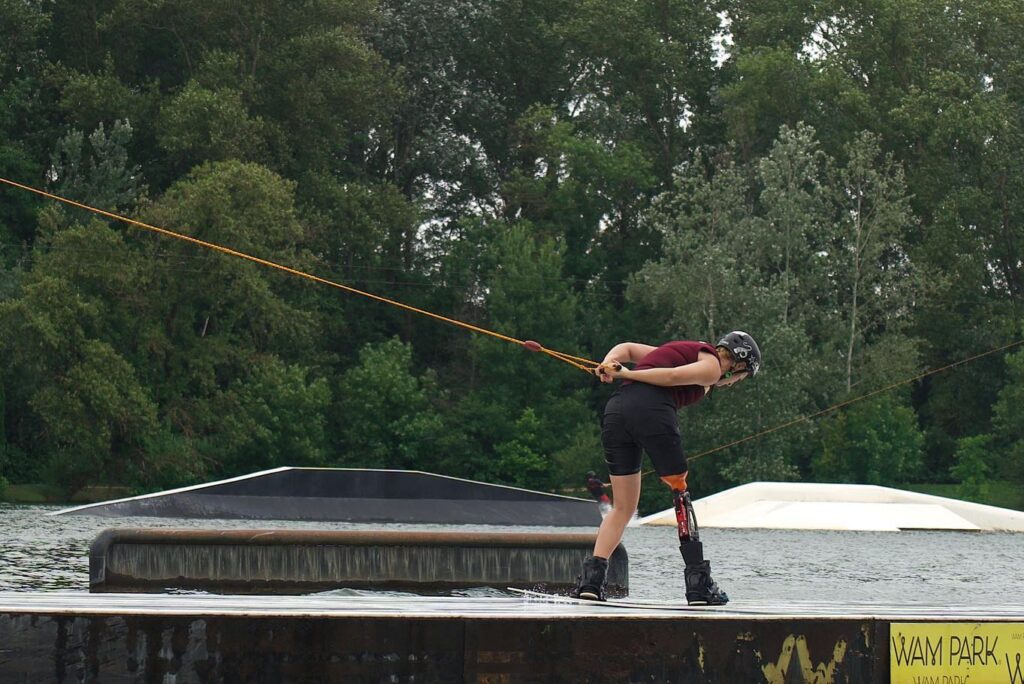
Q: You mentioned that sport is vital to rebuilding a person’s life. Can you elaborate on this belief and how it has influenced your advocacy work?
Lorsque l’on est amputé de la jambe, il faut tout réapprendre. Comme un enfant, il faut réapprendre à marcher, c’est tellement dur et on y met tellement d’énergie, qu’ensuite on veut essayer de courir, puis réapprendre à faire du vélo, etc… Tout cela nous donne des objectifs, on persévère, et lorsqu’on y arrive, on est fier et on peut ensuite déplacer des montagnes. On sait que les prothèses de sport existent et on peut les essayer. Mais malheureusement on ne peut pas les acheter. Imaginez-vous faire essayer une lame de course à votre enfant amputé, et le voir courir pour la 1ere fois, mais lui dire que non, que ce n’était que pour aujourd’hui. Nous avons tous vécu ce moment où nous avons dû rendre la prothèse à la fin de la journée, et ce dire que c’était fini. Générations Avant-Garde a offert des prothèses à des personnes amputées depuis 20 ou 30 ans, et qui n’avaient jamais couru de leur vie, mais qui en ont toujours rêvé.
When your leg is amputated, you have to relearn everything. Like a child, you have to learn to walk again; it’s so hard, and you put so much energy into it that then you want to try running, then learn to ride a bike again, etc… All this gives us goals, we persevere, and when you succeed, you are proud, and you can then move mountains. We know that sports prostheses exist, and we can try them. But unfortunately, we cannot buy them. Imagine having your amputee child try a running blade and seeing them run for the first time, but telling them no, that it was only for today. We’ve all had that moment where we had to return the prosthesis at the end of the day and say it was over. Générations Avant-Garde offered prostheses to people who had been amputees for 20 or 30 years and who had never run in their lives but who always dreamed of it.
Q: What specific initiatives or projects have “Génération Avant-Garde” undertaken to promote access to sports for amputees?
Génération Avant-Garde se bat politiquement pour que les prothèses soient prises en charge par la sécurité sociale. Beaucoups de choses sont possible, aujourd’hui il faudrait trouver le moyen pour que les mutuelles interviennent aussi. La loi a enfin été adoptée cette année. Mais nous n’avons toujours pas le décret d’application. Il ne faut rien lâcher, sinon on ne l’aura jamais. Je ne doute pas que nous y arriverons, mais dans combien de temps ? En attendant, c’est toute une génération qui est impactée. On peut faire plus de choses, et on veut en faire plus ! On nous demande de rester debout, mais pour cela il faut rester musclé, donc faire du sport debout, avec prothèse, la sécurité sociale devrait le comprendre.
Génération Avant-Garde is fighting politically to ensure that prostheses are covered by social security. Many things are possible today. We need to find a way for mutual societies to intervene, too. The law was finally adopted this year. But we still do not have the implementing decree. You must not let go of anything. Otherwise, you will never have it. I have no doubt we will get there, but how soon? In the meantime, an entire generation is impacted. We can do more things, and we want to do more! We are asked to stand, but for that, we have to remain muscular, so doing sports standing with a prosthesis, social security should understand this.
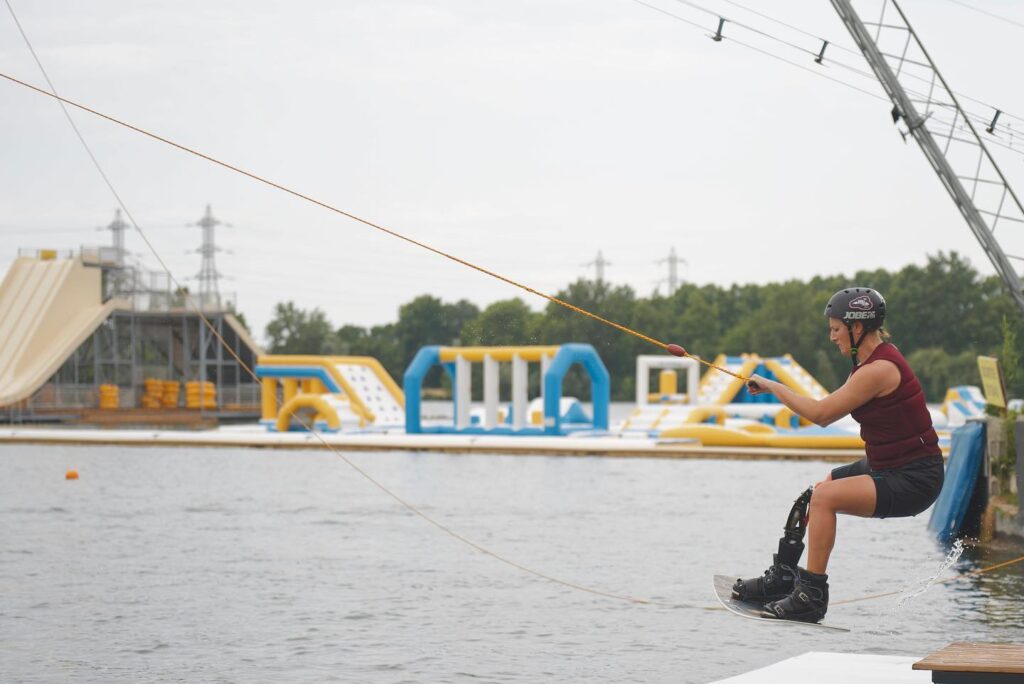
Q: How do you personally support children and teenagers facing osteosarcoma and sarcoma before and after amputations as a patient partner at the hospital?
A la demande du patient, je me déplace pour les rencontrer en pré ou post amputation. Car je sais “oh combien on est perdu” lorsqu’il nous arrive un tel drame. Donc je leur explique qu’ils pourront tout de même faire des activités super funs. Qu’il faudra sûrement adapter des choses, revoir leurs objectifs de vie mais parfois pour du mieux, etc… Et je leur parle des associations existantes qui proposent des activités, je leur montre des images sur les réseaux sociaux d’amis à moi qui font différents sports, ou de personnes amputées qui ont les mêmes centres d’intérêts que le patient pour qu’ils puissent se projeter. C’est l’inconnue qui fait peur et qui terrorise. Mais, néo-amputé, je fais très attention aux images que je montre. Un jeune homme va adorer les images de sport, alors que les jeunes femmes vont chercher comment redevenir jolies avec une prothèse… Et bien sûr, je leur explique que la rééducation va être longue et difficile, mais qu’il ne faut rien lâcher car au bout ça vaut le coup.
At the patient’s request, I travel to meet them pre or post-amputation. Because I know “oh, how lost we are” when such a tragedy happens. So I explained that they would still be able to do super fun activities. They will indeed have to adapt things review their life goals, but sometimes for the better, etc… And I talk to them about existing associations that offer activities, I show them images on social networks of friends of mine who are doing different sports or amputees who have the same interests as the patient so that they can project themselves. It’s the unknown that scares and terrorizes. But, as a new amputee, I am cautious about the images I show. A young man will love sports images, while young women will look for ways to become pretty again with a prosthesis… Of course, I explain to them that the rehabilitation will be long and arduous but that we must not give up because it’s worth it.
Q: Congratulations on winning the silver medal in the 2023 European Para-Snowboard Cup! Can you share some of the highlights of your journey in para-snowboarding?
Cela faisait plus de 10 ans que je gardais mes affaires de snowboard dans l’espoir de pouvoir en refaire un jour. Puis, lorsqu’on m’a amputé de la jambe, je me suis dit que cette fois-ci c’était fini, et j’ai mis ma planche de snowboard en vente sur internet. Un jour, un athlète paralympique les as vu et me contacta en m’expliquant qu’il avait créé une prothèse de snowboard. Je n’y croyais pas !!!! Le moment le plus fort à été lorsqu’il m’a emmené sur le glacier des 2 Alpes à 3600 mètres d’altitude. C’était la 1ere fois que je retournais sur la neige. 10 ans que je n’avais pas vu un flocon de neige. Ça m’avait tellement manqué, que je n’ai pas arrêté d’en faire. Imaginez-vous que j’ai mis 1 an et demi à remarcher correctement, et 2 jours pour faire du snowboard. Il m’a entraîné et j’ai pu aller aux Championnats de France 9 mois plus tard où j’ai terminé 3ème.
I had been saving my snowboard gear for over 10 years in the hope of being able to do it again one day. Then, when my leg was amputated, I told myself that this time it was over, and I put my snowboard for sale on the internet. One day, a Paralympic athlete saw them and contacted me, explaining that he had created a snowboard prosthesis. I do not believe it !!!! The most decisive moment was when he took me to the 2 Alpes glacier at 3600 meters above sea level. It was the first time I returned to the snow. 10 years since I saw a snowflake. I missed it so much that I didn’t stop doing it. Imagine it took me a year and a half to walk correctly again and 2 days to snowboard. He trained me, and I could go to the French Championships 9 months later, where I finished 3rd.
Q: Looking ahead, what are your aspirations and expectations as a medal contender in the upcoming Paralympic Games?
Les Jeux Paralympiques d’hiver seront en 2026 et les Championnats du Monde en 2025. Pour moi, simplement y participer est un honneur et une consécration. Le snowboard est une passion depuis mon adolescence, je découpais les photos et les affichait au mur de ma chambre. Rider est indispensable pour mon équilibre de vie. Je ride tous les jours quand je peux, sur la neige ou sur l’eau. Il me manque une jambe, il est plus facile pour moi de glisser que de marcher. Avec mon niveau, je suis médaillable au Championnat du Monde, mais pour y arriver, la passion n’est pas suffisante, il faut s’en donner les moyens et s’organiser pour avoir le plus gros programme d’entraînements et s’entourer de toute une équipe qui m’aidera à performer.
The Winter Paralympic Games will be in 2026, and the World Championships in 2025. For me, simply participating in them is an honour and a consecration. Snowboarding has been a passion since I was a teenager; I cut out photos and hung them on my bedroom wall. Riding is essential for my life balance. I ride every day when I can, on snow or water. I’m missing a leg; it’s easier for me to slide than to walk. At my level, I am a medalist at the World Championship, but to get there, passion is not enough; you have to give yourself the means and organize yourself to have the most extensive training program and surround yourself with a whole team that will help you perform.
Q: Winning two gold medals nationally in Para-Wakeboarding is a remarkable achievement. Can you describe the feeling of standing on the podium and what these victories mean to you?
Je n’y croyais pas la 1ere fois, et la deuxième fois je m’étais mis tellement la pression car je savais que ma compétitrice avait bien progressé. Mais pour moi, la compétition et les médailles ont plus de sens, comme promouvoir le Parawakeboard féminin, et montrer que les femmes handicapées sont capables elles aussi. Mais aussi pour donner de la visibilité et motiver les fabricants à nous créer et améliorer nos prothèses.
I didn’t believe it the first time, and the second time, I put so much pressure on myself because I knew that my competitor had progressed well. But for me, the competition and the medals have more meaning, like promoting women’s Parawakeboarding and showing that disabled women are capable too. But also to give visibility and motivate manufacturers to create and improve our prostheses.
Q: Practicing sports with prostheses is impressive. Could you share insights into the challenges and rewards of participating in these activities with limb differences?
Il faudrait que vous les essayez pour vraiment vous rendre compte de la difficulté que c’est de faire du sport avec une prothèse. Je suis amputée fémorale, donc je n’ai pas de genoux, ni de cheville, et ses articulations sont remplacées par de simples amortisseurs de vélos. Il nous manque l’équilibre, nous sommes comme sur une échasse qui plie et cela à toute vitesse dans la pente avec des sauts, des virages et des obstacles. Par contre, la vitesse nous donne de l’inertie et c’est ce qui nous permet de rester en équilibre. Mais une fois à l’arrêt, on ne tient pas debout donc on s’allonge par terre.
On passe beaucoup de temps à essayer la prothèse, à l’enfiler, la porter, la régler, la réparer, l’entretenir. Après chaque sortie. Tout ce temps c’est du temps en plus le soir. Donc oui, il est évident que je suis très fière d’arriver à faire du snowboard, et du beau snowboard. On ne sera jamais au niveau d’athlètes valides, mais rien que d’être là, c’est déjà une victoire.
You should try them to realize how difficult it is to play sports with a prosthesis. I am a femoral amputee, so I have no knees or ankles, and my joints are replaced by simple bicycle shock absorbers. We lack balance; we are like on a bending stilt, and this at full speed down the slope with jumps, turns and obstacles. On the other hand, speed gives us inertia, and this is what allows us to stay in balance. But once you stop, you can’t stand up, so you lie on the ground.
We spend a lot of time trying on the prosthesis, putting it on, wearing it, adjusting it, repairing it, and maintaining it. After each outing. All this time is extra in the evening. So yes, it’s apparent that I’m very proud to be able to snowboard, and beautiful snowboarding. We will never be at the level of able-bodied athletes, but just being there is already a victory.
Q: Your fight for the reimbursement of prostheses is commendable. Can you explain the importance of this advocacy and its impact on the amputee community?
Aujourd’hui, dans les pays occidentaux, être appareillé d’une prothèse est acquis. Mais ça n’enlève pas la difficulté de la porter et de marcher avec. Il y a des obstacles partout où on passe. Nous avons un handicap lourd où le moindre mouvement, déplacement est un effort surhumain. Bien entendu, nous avons la possibilité d’être debout, donc nous souhaitons rester debout le plus longtemps possible. Pour cela nous devons faire du sport debout, se renforcer, se muscler, sinon on ne tiendra pas le coup dans les difficultés du quotidien, et on restera assis. Assis, nous sommes beaucoup plus dépendant des autres, et tout une partie de notre corps n’est donc pas utilisé et va s’atrophier. Avoir les prothèses de sport accessibles à tous, est un enjeu majeur pour que nous restions debout. Les technologies évoluent, mais si c’est pour ne pas arriver à les utiliser au quotidien alors ça ne sert à rien.
Today, in Western countries, being fitted with a prosthesis is a given. But that doesn’t take away the difficulty of carrying it and walking with it. There are obstacles everywhere we go. We have a severe handicap where the slightest movement is a superhuman effort. Of course, we have the option of standing, so we want to stay standing as long as possible. To do this, we must do sports classes, strengthen ourselves, and build muscle; otherwise, we will not survive the difficulties of everyday life, and we will remain seated. Sitting, we are much more dependent on others, and a whole part of our body is therefore not used and will atrophy. Having sports prostheses accessible to all is a significant challenge for us to stay upright. Technologies evolve, but if it means you can’t use them daily, then it’s useless.
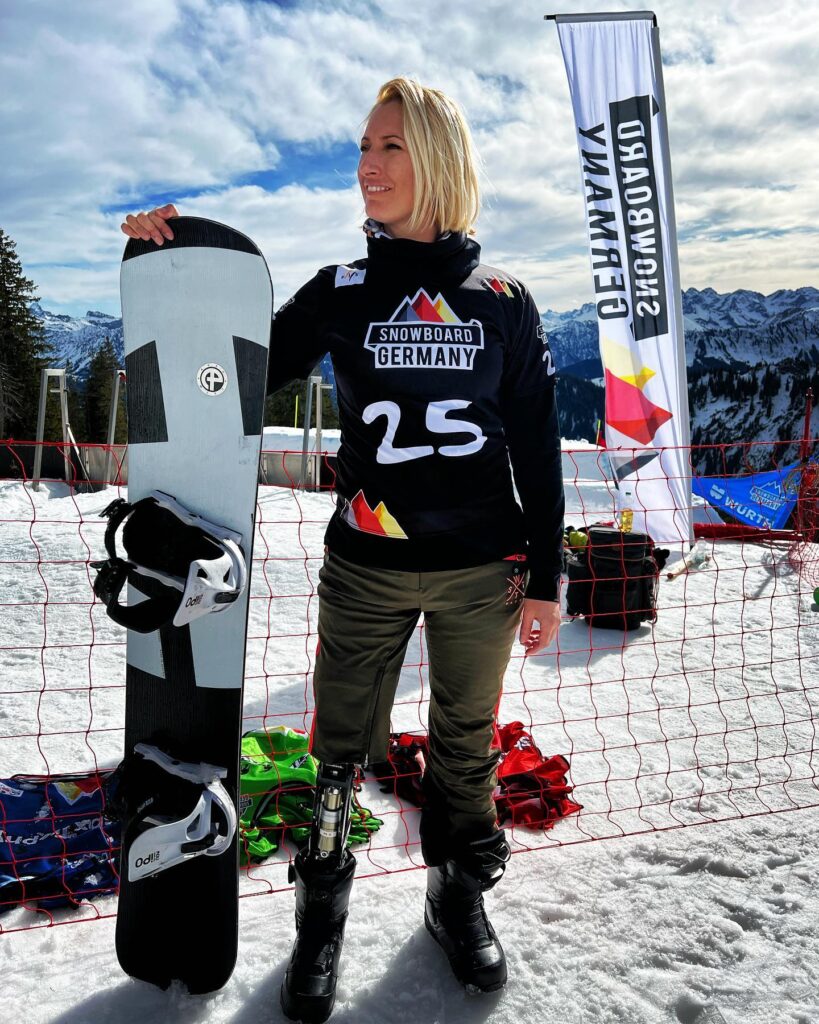
Q: How can the broader community support your efforts in advocating for reimbursement of prostheses and the success of the next Paralympic Games?
Au final, le plus gros obstacle, c’est d’arriver à s’acheter son appareillage et son matériel. Beaucoup d’athlètes à haut potentiel ne peuvent se lancer par manque de moyens financiers, et il faut trouver une grosse somme dès le début !!! Si j’ai décider de faire de la compétition c’est en priorité pour donner de la visibilité, faire en sorte de donner envie aux gens de nous suivre, de partager nos histoires, nos aventures. C’est comme ça que je me bats pour cette cause. Et on espère que les Jeux Paralympiques nous mettront en lumière, les réussites, mais aussi les problématiques et que ça fera évoluer les lois pour les prochaines générations.
Finally, the biggest hurdle is being able to purchase your equipment and materials. Many high-potential athletes cannot start due to a lack of financial resources, and you have to raise a large amount of money right from the start!!! If I decided to compete, it was mainly to provide visibility, to inspire people to follow us, to share our stories and our adventures. This is how I fight for this cause. We hope that the Paralympic Games will highlight the successes and problems and that this will change the law for the next generations.
Q: Looking beyond your achievements and advocacy, what advice do you have for individuals who may be facing their own health challenges or limb differences and are seeking inspiration and hope?
Les maladies et les différences font peur. Il y a des gens qui pensent peut-être qu’on peut les contaminer (lol). J’ai été très malade, et aujourd’hui j’ai une différence physique qui en rebute certains. Mais ça m’est égal, le regard des autres je m’en fiche, et je montre tout le temps ma différence, ça les éduque, je me dis que le jour où ils vivront une difficulté ils seront mieux préparés parce qu’ils auront vu que l’on peut vivre et se reconstruire malgré cela.
It’s scary to have diseases and differences. There are probably some people who think we could make them sick (laughs). I’m sick, and today, my body looks different in a way that makes some people angry. But it doesn’t bother me; I don’t care about how other people look, and I show my difference all the time; it teaches them, and I tell myself that the day they have a problem, they will handle it better. We will be ready because they will be given to us so we can live through it and start over.
